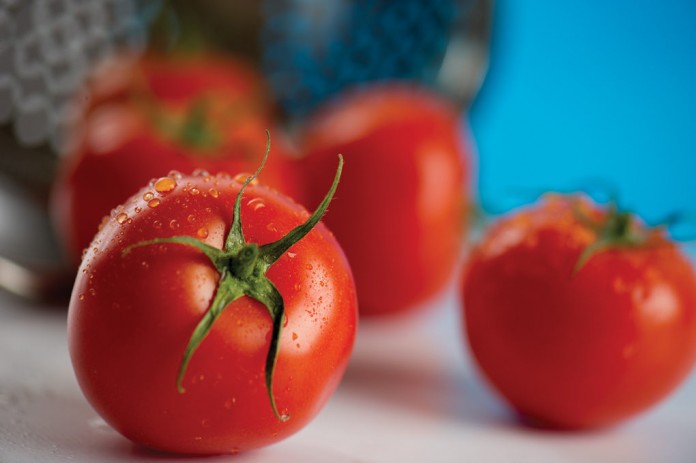BLOOMINGTON, Ind. — Tomatoes are in almost everything we eat, from salad and soup to chili and pizza.
Most people don’t realize, however, that there are more than a dozen wild tomato species, or that wild tomatoes grow in the deserts, rainforests and highlands of South America and on the Galapagos Islands.
These wild species don’t have the big, bold fruits we’re used to seeing in the supermarket, though. Wild tomato fruits are smaller, from the size of a pea to that of a large marble, and are sometimes green and bitter when they’re ripe.
But compared with their domesticated relatives, wild tomatoes are more diverse in many hidden and not-so-hidden ways.
Now scientists are using the genomes of wild tomatoes to study the processes that drive Earth’s biodiversity. Their goal is to learn how species cope with differences in climate and natural enemies, and what might happen in this time of environmental change.
Biodiversity and tomatoes
To study natural trait and genome diversity in wild tomatoes, scientists Leonie Moyle, David Haak and Matthew Hahn, of Indiana University Bloomington, received a grant from the National Science Foundation’s Dimensions of Biodiversity program.
“The resulting discoveries go beyond expanding our knowledge of the depth and breadth of life on Earth,” says John Wingfield, NSF assistant director for biological sciences.
“They have the potential to revolutionize the way we manage agriculture, practice medicine, address global climate change and develop new technologies.”
Sequencing
The award to Moyle’s team funds sequencing of the complete set of all expressed genes (the transcriptome) in populations of wild tomato species.
“Variations within and between these wild tomato genomes can be compared by using the genome sequence of the domesticated tomato as a ‘backbone,'”says Moyle.
By linking this genome-wide sequence data with information on wild tomato trait variation, the biologists hope to identify the genes responsible for adaptation to environmental change. The research focuses on the role of drought and of defense against herbivores, or plant-eaters, in the diversity of wild tomatoes.
“These factors,” says Haak, “capture two of the most important aspects of any plant’s environment: climate and natural enemies.”
Wild tomatoes
While domesticated tomatoes thrive only in agricultural irrigation, wild tomatoes live in some of the planet’s most extreme environments. They’re among the few plants found in the driest place on Earth — the Atacama Desert, in Chile.
Other wild tomatoes blossom along the rocky, salty shores of the Galapagos Islands, and in the daily rains of Ecuador’s rainforests.
But it’s not just the climate in which they grow that varies among wild tomatoes. The plants bristle with an array of natural defenses, from dense coverings of plant hairs to toxins deadly against insect attackers.
Plant defenses
In a forthcoming paper Haak, Moyle and colleagues document large differences in defenses among wild tomatoes. They used bioassays — experiments in which living organisms are used to reveal the potency or concentration of a substance.
In this case, they fed leaf samples of different wild tomato species to tobacco hornworms.
The tobacco hornworm — also known as the tomato hornworm — is an enemy of both domesticated and wild tomatoes. It rapidly eats its way through the plants’ leaves.
Each hornworm caterpillar was weighed before and after feeding to determine how much it had gained on a diet of wild tomato leaves. Those tomatoes on which caterpillars gained little or no weight, says Haak, have more natural defenses than those on which the caterpillars gained weight.
In one wild tomato species, caterpillars lost significant weight; they refused to consume the plant’s toxic leaves.
The researchers showed the level of natural defense varies widely among wild tomato species.
“Although all wild tomatoes are closely related, these patterns of defense variation don’t simply follow historical, evolutionary relationships,” says Moyle. “The defense level of each wild tomato population is likely shaped by responses to local herbivores.”
Environmental responses
Moyle and Haak are using DNA sequencing to look at the genes that are expressed differently in wild tomatoes with varying levels of natural defenses, and with differences in responses to drought.
Genes that are consistently up- or down-regulated in these conditions, says Moyle, can reveal the changes important for responding to and coping with environmental stresses.
“By linking data on DNA sequence variation, and on variation in gene expression, with wild tomatoes’ responses to drought and natural enemies,” she says, “we may find a powerful model for understanding the genetics of responses to environmental change.”
Variations
The study could also uncover genetic variations helpful in improving domesticated tomatoes and their cultivated relatives, including potatoes and peppers.
“This research on tomatoes’ wild relatives offers insights into the huge reservoir of genetic information available to ensure our future food security,” says Simon Malcomber, lead NSF program director for Dimensions of Biodiversity.
“Tomatoes are one of the most widely consumed foods around the world,” he says.”Studies such as this provide important information that could be used to improve herbivore resistance in crop cultivars.”
Next time you’re in the supermarket, tomatoes are worth a closer look. These common plants may offer a glimpse of our global food security, and of Earth’s environmental future.












